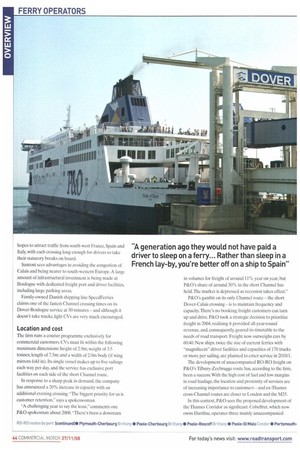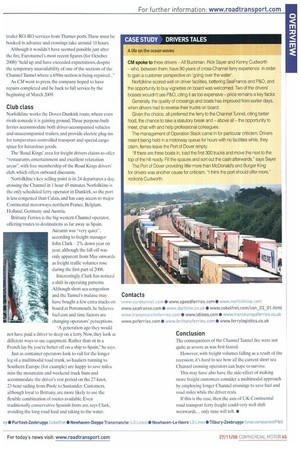A sea change...
Page 42

Page 44

Page 45

If you've noticed an error in this article please click here to report it so we can fix it.
What effects has the Eurotunnel fire and the economic slump had on Channel hopping operators this year?
Words: Dave 'young
Cross-Channel freight ferry routes make up a highly competitive shipping sector, and stretch from the Thames Estuary as far west as Plymouth. The bulk of activity is in the Dover-Calais corridor. but Portsmouth now offers the widest choice of destinations.
A Channel Tunnel fire in September 2008 provided a short-term bonus for ferry lines, but they were facing up to their own problems. Bad weather, the SeaFrance strike, congestion at Calais and port blockades on the French side all contributed towards making Operation Stack a depressingly familiar occurrence for drivers regularly 'doing Continental'.
One industry expert speaks of "a structural 50% overcapacity on short sea Channel crossing routes. Outsiders seem to view it with envy, but you have to take a longterm view if you want to be a player". The main 'combatants in the short sea "battleground" are Eurotunnel (40%), P&O (30%), SeaFrance (20%) and Norfolkline (10%).These figures are open to debate, since there are several other players.
Brittany Ferries dominates the longer west Channel crossings, while the Thames Estuary, earmarked for economic growth, provides embarkation mainly for unaccompanied RO-RO (roll-on, roll-off) alternatives.
From a customer point of view, intense competition and plenty of routes to different destinations help keeps the lid on prices, but many drivers rightly bemoan the lack of decent facilities at ports on the English side.
Newcomer LD Lines has received approval for the introduction of a mixed passenger/freight service on the Dover-Boulogne route from July 2009, and is also discussing the possibility of a new Dover-Dieppe crossing. The new Dover-Boulogne service will provide four return sailings daily with a crossing time of one hour 45 minutes on the Norman Spirit, which will transfer from LD Lines' Portsmouth-Le Havre service and has capacity for 110 freight vehicles.
Traffic volumes
In the first year of operation, the company — whose ships bear the Transmanche name on some routes — expects to carry in the region of 120,000 trucks. The construction of Boulogne's new RO-RO terminal and the first linkspan began in the second half of 2008, and will be operating by 1 July 2009.
LD Lines managing director Christophe Santoni says traffic volumes increased after the Chunnel lire and remain at a high level; an increase he also attributes to the reliability of the Newhaven-Dieppe service, which LD took over 18 months ago, and has proved popular with trucks from Spain. In the first nine months of 2008,37,000 vehicles were carried — 5,0rJO more than in the whole of 2007.
Asked if opening routes at a time of recession will prove viable, Santoni says the French firm — part of the 60-vessel Louis Dreyfus Armateurs — "always see ferries as a long-term investment". By running into Dieppe, it hopes to attract traffic from south-west France, Spain and Italy, with each crossing long enough for drivers to take their statutory breaks on board.
Santoni sees advantages in avoiding the congestion of Calais and being nearer to south-western Europe. A large amount of infrastructural investment is being made at Boulogne with dedicated freight port and driver facilities, including large parking areas.
Family-owned Danish shipping line SpeedFerries claims one of the fastest Channel crossing times on its Dover-Boulogne service at 50 minutes — and although it doesn't take trucks, light CVs are very much encouraged.
Location and cost
The firm runs a courier programme exclusively for commercial customers CVs must fit within the following maximum dimensions: height of 2.9m; weight of 3.5 tonnes; length of 7.5m; and a width of 2.0m body (if wing mirrors fold in). Its single vessel makes up to five sailings each way per day, and the service has exclusive port facilities on each side of the short Channel route.
In response to a sharp peak in demand, the company has announced a 20% increase in capacity with an additional evening crossing. "The biggest priority for us is customer retention," says a spokeswoman.
"A challenging year to say the least," comments one P&O spokesman about 2008. "There's been a downturn in volumes for freight of around 11% year on year, but P&O's share of around 30% in the short Channel has held. The market is depressed as recession takes effect."
P&O's gambit on its only Channel route — the short Dover-Calais crossing — is to maintain frequency and capacity. There's no booking; freight customers can turn up and drive. P&O took a strategic decision to prioritise freight in 2004, realising it provided all-year-round revenue, and, consequently, geared its timetable to the needs of road transport. Freight now outweighs cars by 60:40. New ships, twice the size of current ferries with "magnificent" driver facilities and capacities of 170 trucks or more per sailing, are planned to enter service in 2010/1.
The development of unaccompanied RO-RO freight on P&O's Tilbury-Zeebrugge route has., according to the firm, been a success With the high cost of fuel and low margins in road haulage, the location and proximity of services are of increasing importance to customers — and ex-Thames cross-Channel routes are closer to London and the M25.
In this context, P&O sees the proposed development of the Thames Corridor as significant. Cobeifret, which now owns Dartline, operates three mainly unaccompanied trailer RO-RO services from Thames ports. These must be booked in advance and crossings take around 10 hours.
Although it wouldn't have seemed possible just after the fire, Eurotunnelfs most recent figures (for October 2008) "held up and have exceeded expectations, despite the temporary unavailability of one of the sections of the Channel Tunnel where a 650m section is being repaired..."
As CM' went to press, the company hoped to have repairs completed and be back to full service by the beginning of March 2009.
Club class
Norfolkline works the Dover-Dunkirk route, where even rivals concede it is gaining ground.Three purpose-built ferries accommodate both driver-accompanied vehicles and unaccompanied trailers, and provide electric plug-ins for temperature-controlled transport and special cargo space for hazardous goods.
The 'Road Kings' area for freight drivers claims to offer "restaurants, entertainment and excellent relaxation areas", with free membership of the Road Kings drivers' club, which offers onboard discounts.
Norfolkline's key selling point is its 24 departures a day, crossing the Channel in 1 hour 45 minutes. Norfolkline is the only scheduled ferry operator in Dunkirk, so the port is less congested than Calais, and has easy access to major Continental motorways, northern France, Belgium, Holland, Germany and Austria.
Brittany Ferries is the big western Channel operator, offering routes to destinations as far away as Spain. Autumn was "very quiet", according to freight manager John Clark — 2% down year on year, although the fall-off was only apparent from May onwards as freight traffic volumes rose during the first part of 2008.
Interestingly, Clark has noticed a shift in operating patterns. Although short sea congestion and the Tunnel's malaise may have bought a few extra trucks on board at Portsmouth, he believes fuel cost and time factors are changing operators' perceptions.
"A generation ago they would not have paid a driver to sleep on a ferry. Now, they look at different ways to use equipment. Rather than sit in a French lay-by, you're better off on a ship to Spain," he says.
Just as container operators look to rail for the longer leg of a multimodal road trunk, so hauliers running to Southern Europe (for example) are happy to save miles, miss the mountains and weekend truck bans and accommodate the driver's rest period on the 27-knot, 23-hour sailing from Poole to Santander. Customers, although loyal to Brittany, are more likely to use the flexible combination of routes available. Even traditionally conservative Spanish firms are, says Clark, avoiding the long road haul and taking to the water.
Conclusion
The consequences of the Channel Tunnel fire were not quite as severe as was first feared.
However, with freight volumes falling as a result of the recession, it's hard to see how all the current short sea Channel crossing operators can hope to survive.
This may have also have the side-effect of making more freight customers consider a multimodal approach by employing longer Channel crossings to save fuel and road miles while the driver rests.
If this is the case, then the axis of UK-Continental road transport ferry freight could very well shift westwards... only time will tell. •




















































































































































